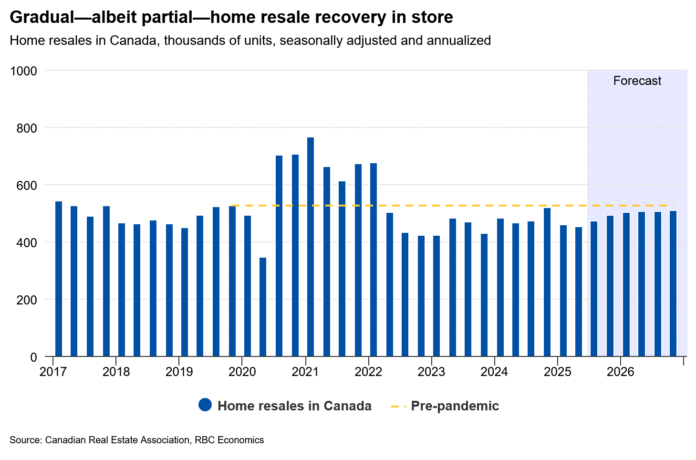Home sales are gaining traction again after a difficult winter and spring. July marked the fourth straight monthly increase, with national activity up 3.8% from June and more than 11% above March lows. The Greater Toronto Area has been a key driver, where transactions have surged 35.5% over that stretch.
Despite these signs of renewed momentum, RBC Economics cautions that the recovery will be uneven. Its latest forecast projects national resales will fall 3.5% this year before rebounding in 2026, while prices are expected to slip next year under the weight of Ontario and B.C.’s high inventories.
“Encouragingly, recent signs of an ongoing recovery have emerged,” said Robert Hogue, assistant chief economist at RBC. “Prospective buyers are re-entering the market as economic fears ease and lower interest rates gain traction. We expect this gradual recovery to continue in the second half of 2025, setting the stage for stronger demand in 2026.”
Brighter outlook for 2026
RBC sees resales rebounding 7.9% next year to 504,100 units, more than offsetting this year’s decline but still falling short of pre-pandemic norms. The forecast calls for improving job conditions and lower borrowing costs to help bring more buyers back, although affordability pressures will cap how far demand can run.
The unemployment rate is expected to peak at 7.1% later this year before easing in 2026, giving households more confidence to make longer-term commitments like home purchases.
Prices under pressure in key markets
National prices are expected to edge up by 0.7% this year, but RBC says those gains are front-loaded. It projects a 0.7% decline in 2026 as Ontario and B.C. continue to face decade-high levels of supply and strong competition among sellers.
“Until then, strong competition among sellers will likely keep prices under pressure with declines continuing into early 2026 before steadying,” Hogue noted.
In contrast, tighter markets in Quebec, the Prairies and parts of Atlantic Canada are expected to see modest price increases over the next two years.
Structural challenges linger
While lower interest rates have helped bring ownership costs to their most affordable level in three years, RBC says affordability remains well above pre-pandemic levels in the country’s priciest markets.
Hogue adds that the Bank of Canada’s rate cuts since mid-2024 “have yet to fully play out,” with last fall’s recovery cut short by the trade war. He expects momentum to resume as borrowing costs filter through, but doesn’t anticipate further stimulus, with RBC’s forecast calling for the policy rate to hold at 2.75% through 2026 and longer-term rates drifting higher as markets scale back expectations for additional easing.
Demographic shifts are also expected to weigh on demand, with reduced immigration targets slowing household formation and keeping investor activity muted in major urban centres.
According to RBC, the softness reflects a correction from the pandemic boom. Rock-bottom rates, income supports and shifting housing needs pulled demand forward, leaving the market to gradually settle back into balance.


Visited 62 times, 62 visit(s) today
Dashboard existing home sales house price forecast housing forecast housing outlook rbc economics real estate Robert Hogue
Last modified: August 21, 2025
